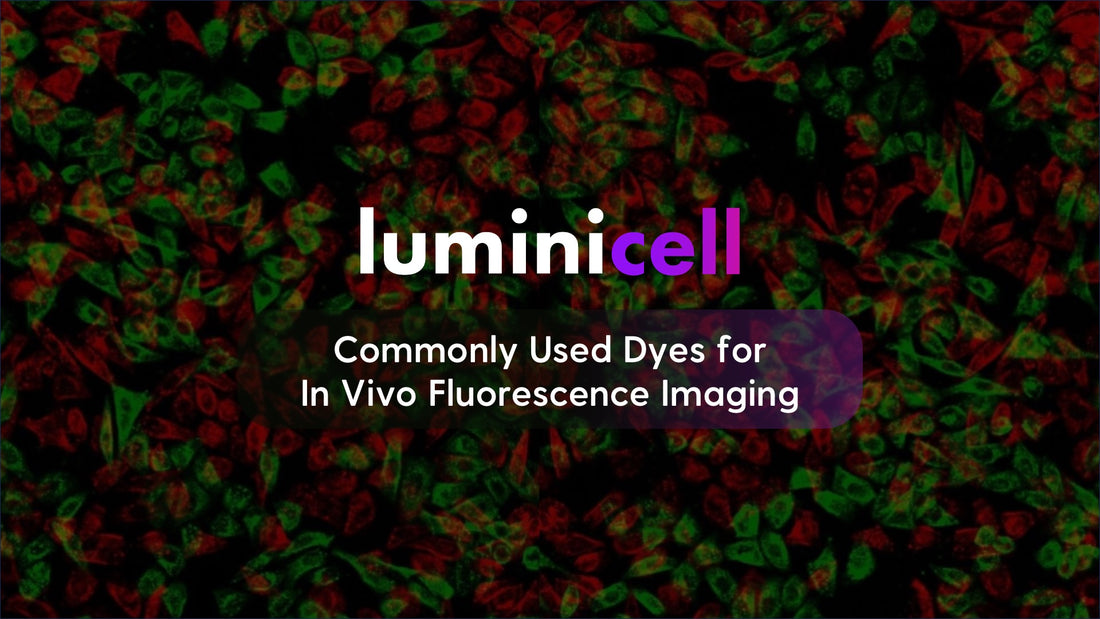In vivo Imaging
In vivo imaging technology is a valuable method in biomedical research and clinical applications for conducting long-term studies on living animals, visualise and study the biological processes without causing any harm. Current available techniques can be classified into five major categories: Optical Imaging, Positron Emission Tomography/Single Photon Emission Computed Tomography (PET/SPET), Magnetic Resonance Imaging (MRI), Computed Tomography (CT), and Ultrasound Imaging. In this blog post, we will be introducing the use of optical imaging and some commonly used fluorescent dyes in the in vivo imaging experiments.
Optical Imaging
Live optical imaging utilizes sensitive optical detection instruments to monitor activities within living organisms, including observation of tumour growth and metastasis within animals, the distribution of transplanted cells within the body, the targeting effect and distribution of drugs, and the development of infectious diseases, etc.
In vivo optical imaging comprises two techniques: bioluminescence imaging and fluorescence imaging. Bioluminescence technology involves integrating the luciferase gene into the chromosome DNA of target cells to stably express luciferase, which can catalyse the exogenous substrate luciferin to produce bioluminescent signals. On the other hand, fluorescence technology uses specific excitation light to stimulate fluorescent reporter groups, resulting in emission. There are two approaches of introducing fluorophores into biosystems: (1) integrating fluorescent protein genes into target cells; (2) labelling cells, biomolecules, or drugs with fluorescent dyes.
Fluorescent dye labelling offers advantages such as simple protocol, rapid imaging, and visualizable results, making it widely accepted and having potential for clinical translation. Various dyes are employed to label and track specific cells, drugs and tissues. Here are some commonly use dyes for in vivo fluorescence imaging:
Cyanine dyes
Among the Cyanine dyes, Cy5.5, Cy7, and Cy7.5 are suitable for biological imaging due to their longer emission wavelengths and enhanced tissue penetration capabilities. These organic small molecules can be used to label drugs and biomolecules, such as antibodies, for studying the effects and biological processes that occur when these drugs or molecules are introduced into a living organism.
DiD / DiR
DiD (red) and DiR (NIR), as lipophilic fluorescent dyes, can be used to label cell membranes and other lipid structures. In the in vivo imaging, DiD or DiR can be applied to track the in vivo distribution and migration of the labelled cells. They can also be used to label micelles or liposomes used for drug/gene delivery, allowing for the evaluation of the targeting properties of these micelles or liposomes.
Quantum dots
Compared to small organic fluorescent dyes, quantum dots based materials offer higher fluorescence brightness and better photostability, making it suitable for long-term cell imaging.
Luminicell TrackerTM Cell Labelling Kit
The Luminicell Tracker™ Cell Labelling Kit applies advanced nanotechnology to create fluorescent organic nanoparticles (AIE Dots), which show ultrabright fluorescence, extended signal longevity (excellent photostability), and great biocompatibility. These properties make them suitable for long-term imaging of living cells, for both in vitro and in vivo studies. Particularly, Luminicell Tracker™ 670 is well-suited for in vivo imaging of living animals, owing to its red-shifted emission at the far-red to NIR region.
Cells labelled with Luminicell Tracker™ 670 can be used to study the in vivo distribution, cell migration, as well as the cell fate of transplanted cells, such as stem cells and immune cells for cell therapy related studies. In addition, Luminicell Tracker™ can also be applied in mouse tumour models for drug screening and efficacy testing.
As shown in Figure 1, after labelled with Luminicell Tracker™ 670 and implanted into mice, the adipose-derived mesenchymal stem cells (ADSCs) can be tracked using a small animal in vivo imaging system for up to 42 days.

Figure 1. The whole-body fluorescence images of mice in 42 days post transplantation of Luminicell TrackerTM 670 labelled ADSCs. [ACS Nano 2014, 8(12), 12620-12631.]
Summary
In vivo fluorescence imaging technology typically demands for fluorescent dyes with higher brightness, superior signal longevity and photostability, deeper tissue penetration, and most importantly better biocompatibility with minimumtoxicity to cells, tissues, or organisms being imaged.
Selecting the appropriate fluorescent dye depends on specific requirements of the experiment and properties of the biological system under investigation. For example, factors such as intended duration of imaging and depth of imaging should be considered when choosing a suitable fluorescent dyes.
The optical window between far-red to NIR region offers enhanced tissue penetration depth, as well as minimum autofluorescence background, and it is recommended for researchers to choose fluorescent dyes emitting in this range as they are better suitable for in vivo fluorescence imaging studies.
Owing to its combination of photostability, brightness, biocompatibility and long signal duration, Luminicell TrackerTM is well-suited for in vivo imaging application. Users can now gain deeper insights of the labelled cells with real-time monitoring and biodistribution studies, providing essential data for preclinical studies and translational research.

